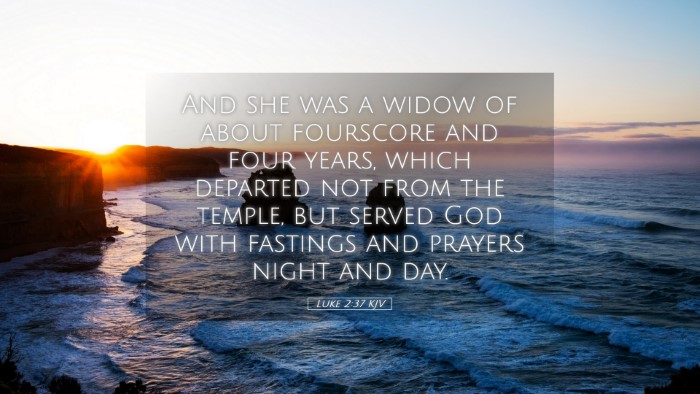Commentary on Luke 2:37
Verse Text: "And she was a widow of about fourscore and four years, which departed not from the temple, but served God with fastings and prayers night and day."
Introduction
The narrative found in Luke 2:37 introduces us to Anna, a significant yet often overlooked figure in the Christmas story and a remarkable model of faithfulness. This commentary will explore the facets of her life and character, drawing insights from public domain commentaries, including those of Matthew Henry, Albert Barnes, and Adam Clarke.
Contextual Background
Lin 2:36-38 details the encounter of Anna, a prophetess, with the newborn Jesus. Set within the larger context of Jesus’ presentation at the temple (Luke 2:22-35), this passage highlights the faithful remnant awaiting the Messiah. Anna’s role is instrumental in affirming Jesus’ significance as God's salvation.
Analysis of the Verse
This verse contains several key elements deserving of deeper examination:
- A Widow: Anna is described as “a widow of about fourscore and four years.” The term 'fourscore and four' denotes 84 years, suggesting a life filled with personal sacrifice and devotion. Matthew Henry notes that her widowhood, while a sign of social vulnerability, enhanced her spiritual insight and dedication.
- Faithful Service: "Departed not from the temple." This detail highlights Anna’s unwavering commitment to her spiritual duties. Albert Barnes implies that her presence in the temple represents a life wholly devoted to worship and prayer, contrasting with the distractions prevalent in society.
- A Life of Prayer and Fasting: “Served God with fastings and prayers night and day.” Anna’s life exemplifies a rhythm of devotion. Adam Clarke underscores that her fasting and prayers indicate not only personal piety but also an intercession for the nation of Israel. Her actions reflect deep faith and an expectation of God's actions.
Theological Implications
The life of Anna brings forth several theological principles relevant to pastors, students, and scholars:
- Perseverance in Faith: Anna’s long-term commitment in the temple represents steadfastness in faith, encouraging believers to remain devoted despite life’s trials. Matthew Henry asserts that true faith often requires patience and endurance over many years.
- The Role of Women in Ministry: Anna’s prophetess status is significant in demonstrating that women play vital roles in God’s plan. In a time when women were often marginalized, her ministry serves as a reminder of the inclusivity of God’s call.
- The Importance of Prayer: Her dedication to prayer underscores its foundational role in the life of a believer. Albert Barnes emphasizes that constant prayer aligns us with God’s purposes, promoting spiritual vigilance.
- Hope in the Messianic Promise: Anna’s recognition of Jesus as the Messiah reflects the culmination of her hopes. Adam Clarke points out that her prophetic acknowledgment signifies the fulfillment of God’s promises, affirming the long-awaited redemption.
Practical Applications
Reflecting on Anna's life leads to several practical applications for modern believers:
- Commitment to Worship: Believers are encouraged to prioritize time in worship, just as Anna did. Her life exemplifies how devotion to God enhances spiritual growth and community impact.
- Engaging in Intercessory Prayer: Following the example of Anna, Christians are called to intercede for others, embracing a life marked by prayer and spiritual vigilance.
- Embracing God’s Plan: Anna’s life invites Christians to remain open to God's unfolding narrative, understanding that their roles, like hers, are essential in the broader context of God’s work in the world.
- Celebrating Female Leadership: The acknowledgment of female figures in scripture, like Anna, encourages the church to recognize and uplift the contributions of women in all forms of ministry.
Conclusion
The story of Anna in Luke 2:37 serves as a profound illustration of a faithful life marked by devotion, perseverance, and prayer. Through the insights of Matthew Henry, Albert Barnes, and Adam Clarke, we glean a deeper understanding of her character and the theological significance of her actions. As we reflect on Anna’s legacy, may we be inspired to embody her commitment in our own lives, encouraging spiritual vitality in our communities and anticipating God's promises with hope.


